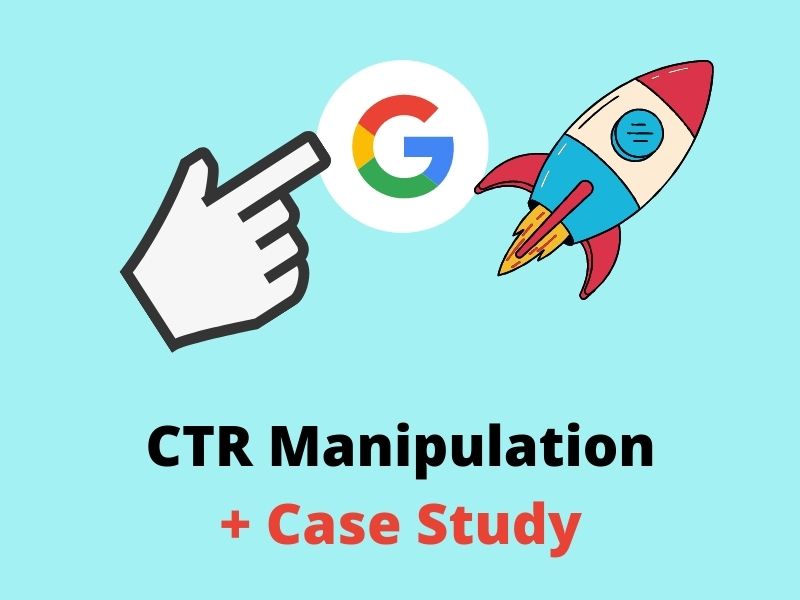GMB CTR Manipulation Explained: What You Need to Know
Understanding CTR Manipulation: Tips for Raised Click-Through Performance
Enhancing click-through rates (CTR) is an essential element of digital advertising and marketing strategies, yet understanding the art of CTR adjustment calls for a nuanced strategy. By concentrating on key elements such as meta descriptions, abundant fragments, and A/B screening, marketing experts can considerably affect the performance of their projects. However, in a landscape where competition is strong and individual behavior regularly evolving, remaining ahead necessitates a deeper understanding of these strategies and a dedication to continual improvement. The world of CTR adjustment holds untapped possibility for those going to discover its ins and outs and unlock its full influence on digital success.

Understanding CTR and Its Effect
Comprehending click-through price (CTR) and its effect is critical for anyone entailed in digital marketing. CTR is an essential efficiency sign that determines the effectiveness of an online advertisement or web content by determining the percentage of users that clicked on a certain link out of the overall variety of impacts it received. A high CTR indicates that the ad or content is reverberating well with the target market, while a reduced CTR recommends the opposite.
CTR is necessary since it directly affects the success of digital advertising projects. A high CTR not just drives more traffic to a site yet also boosts its internet search engine position. Internet search engine like Google think about CTR as a strong signal of an advertisement's relevance and quality, which can lead to higher ad settings and reduced costs per click.
Additionally, recognizing CTR enables marketing experts to maximize their campaigns by examining various ad elements, such as headings, images, and calls-to-action, to enhance efficiency. By examining CTR data, marketers can make informed choices to enhance the efficiency of their digital advertising initiatives.
Crafting Engaging Meta Summaries
Crafting engaging meta descriptions plays an essential role in driving customer involvement and click-through rates on search engine result pages. Meta descriptions are the short bits presented listed below the web page title in search results page, giving a concise recap of the webpage's web content. To develop reliable meta summaries, it is essential to maintain them within the recommended length of around 150-160 characters to guarantee they are completely shown on online search engine results pages.
When crafting meta descriptions, it is necessary to consist of targeted key words relevant to the content of the website. These key words should match the customer's search intent, increasing the chance of individuals clicking via to the web site. Furthermore, incorporating a call-to-action within the meta summary can motivate individuals to take the desired activity, whether it's clicking through to read a write-up, buy, or enroll in a solution.

Leveraging Abundant Bits and Schema Markup
To improve the presence and importance of search engine results, web site proprietors can take advantage of rich bits and schema markup. Rich fragments are additional pieces of details displayed in search get more results page that give individuals with a sneak peek of the web content on a website. By including organized information in the form of schema markup, internet site proprietors can help search engines better comprehend the context of their web content, leading to more informative and visually attractive search engine result.
Implementing schema markup allows search engines to show rich snippets that can consist of information like rankings, reviews, prices, and item schedule directly in the search results. This added info can significantly boost the click-through price by offering customers with a far better click for more info understanding of what the page offers prior to they even visit it. Additionally, rich snippets can make search outcomes stand out from competitors, attracting even more focus and possibly bring about higher click-through prices.
Including abundant bits and schema markup into a website's SEO technique can improve search engine result exposure, increase customer involvement, and ultimately drive more web traffic to the website. - CTR Manipulation Press Release
A/B Evaluating Strategies for Ideal CTR
Enhancing the click-through price (CTR) of a site is critical for optimizing its online efficiency and accomplishing advertising objectives. A/B screening is a powerful approach that enables online marketers to contrast two variations of a website or component to figure out which one executes better in terms of CTR. By carrying out A/B tests, marketing professionals can determine what resonates finest with their target market and make data-driven choices to enhance their CTR.
When executing A/B testing for optimum CTR, it is necessary to concentrate on one variable at once to properly determine its impact. Aspects such as headlines, call-to-action buttons, pictures, or even color design can substantially influence CTR. By checking these elements individually, marketers can pinpoint what drives one of the most interaction from their target audience.
In addition, it is important to make sure that the example size for A/B tests is statistically significant to draw reliable final thoughts. Frequently monitoring and assessing the outcomes of A/B tests will provide useful insights into individual behavior and choices, enabling continuous optimization for boosted click this CTR performance.
Tracking and Evaluating CTR Efficiency
Effective surveillance and evaluation of click-through rate (CTR) efficiency are basic elements of any effective digital marketing technique (GMB CTR Manipulation). By closely checking CTR data, marketing experts can obtain useful insights right into the performance of their projects, permitting notified decision-making and optimization efforts. Routinely tracking CTR metrics across numerous networks and projects offers a thorough sight of audience engagement and campaign performance
Examining CTR performance entails assessing variables such as ad copy, visuals, targeting strategies, and landing web page importance to identify what resonates most with the target audience. By leveraging tools like Google Analytics, marketing professionals can dive much deeper right into CTR trends, segmenting data to recognize efficiency variants throughout different demographics, gadgets, and areas.
Continual surveillance and analysis make it possible for marketers to identify underperforming locations and implement targeted enhancements to enhance CTR (GMB CTR Manipulation). In addition, comparing CTR metrics against market criteria can offer important context and help set reasonable efficiency goals. In general, a data-driven approach to monitoring and evaluating CTR performance is critical for optimizing electronic advertising and marketing efforts and attaining greater click-through performance
Verdict
To conclude, mastering CTR adjustment calls for a strategic technique that focuses on crafting compelling meta summaries, leveraging rich fragments, implementing A/B screening methods, and regularly keeping track of and examining CTR performance. By aligning with user intent, incorporating relevant key words, and using data-driven techniques, businesses can boost their click-through performance and improve overall project efficiency. It is vital to continuously refine and enhance strategies to remain affordable in the electronic landscape.